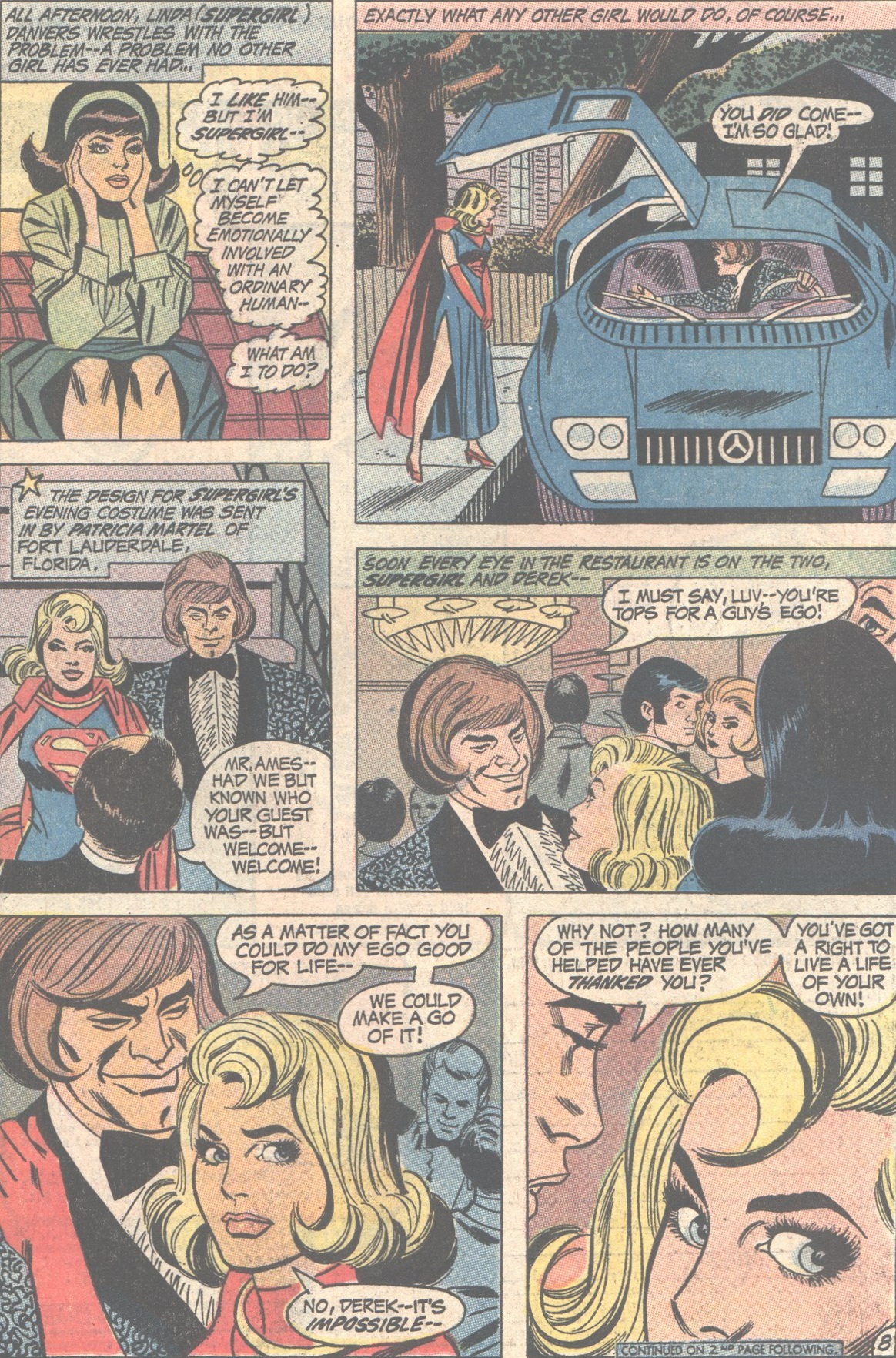
Welcome back to our voyage into the Bronze Age! Once again life has intervened and rather spectacularly ruined my plans for a quicker turn around on this little feature. Things have been difficult here in the Greylands, though I suppose that they are indeed difficult in most places these days. For those of you that pray, I’d appreciate your prayers. We are physically and materially okay, but we are feeling rather worn-down by life at the moment, and there may be more difficult challenges on our horizon. Here’s hoping that 2021 may yet bring us all brighter days.
However, when life gets you down, there are few better escapes than the wonderful world of superhero comics, especially this particularly exuberant variety from the Bronze Age, so let us see what strange marvels the next bit of this month holds for us!
If you’re new to this little journey, you can check out the first post to learn what it’s all about.
Roll Call
(You can see everything published this month HERE)
Action Comics #407Adventure Comics #413Batman #237Detective Comics #418The Flash #211Green Lantern/Green Arrow #87- Justice League of America #95
- Mr. Miracle #5
- Phantom Strange #16
- Superboy #180
- Superman #246 (#245 was all reprints)
- Superman’s Girlfriend, Lois Lane #117
- Superman’s Pal, Jimmy Olsen #144
- Teen Titans #36
- World’s Finest #208
Bolded entries are covered in this post, the others will be covered soon.
Justice League of America #95
Cover Artists: Neal Adams
“The Private War of Johnny Dune!”
Writer: Mike Friedrich
Penciler: Dick Dillin
Inker: Joe Giella
Editor: Julius Schwartz
“How He Began”: Dr. Mid-Nite
Writer: Charles Reizenstein
Artist: Stan Aschmeier
“The Origin of…Doctor Fate”
Writer: Gardner Fox
Artist: Howard Sherman
We’ve got a very interesting story to kick off this set of comics, a tale that wholeheartedly steers into the relevance push of the early Bronze Age, combining a number of different contemporary issues in its plot. The result is a story that is rather fascinating as a representative of its era, even if the plot itself leaves something to be desired. The tale has a solid, if unexceptional cover. Adams’ rendering of our titular antagonist, Johnny Dune, is colorful and interesting, even if he is just wearing “normal” clothes. Well….normal is a relative term in the 70s. Let’s just say that he’s not wearing a costume. The piece captures the basic idea of the conflict, with Johnny having hypnotized the League. I do enjoy the miniature figure of the Tiny Titan trotting along at his feet. It’s not the most exciting of covers, but it does its job and sets the stage reasonably well.
And the show that plays upon that stage begins, not with our titular antagonist Johnny himself, but with Batman and Aquaman preparing to teleport up to the JLA Satellite, only to be scooped up by Superman, who dramatically declares that he is trying to prevent their deaths! In a two-page spread that gives us a nice cross-section of the Satellite, he transports the heroes to their headquarters, and we discover that Flash, Green Lantern, and Hawkman disappeared in some type of teleporter disaster. Fortunately, the world’s greatest detective is on the case!

Meanwhile, we are introduced to the young man from the cover, Johnny Dune, a Vietnam veteran returning home to a country that doesn’t want him. We learn that he fought in several battles of that terrible war, eventually getting wounded and facing certain death at the hands of advancing North Vietnamese troops. In a moment of agony and anger, he cried out for them to stop, and strangely enough, they did. Thus Johnny Dune discovered that he was a mutant with the power to control people with his voice. Despite his newfound power, the young man finds nothing but closed doors and rather unnecessarily discouraging “No Help Wanted!” signs when he returns home. Really, I don’t think it’s necessary to advertise that you don’t have any jobs available. It’s usually the other way around. It’s also interesting that the comic uses the word “mutant”, as you don’t tend to see that term show up as often at DC, given its association with Marvel. Of course, at this point, the original X-Men title had been cancelled, and we were still years away from the beginning of Chris Claremont’s legendary run.
Next, we jump forward in time and join Green Arrow and the Atom as they perform an exhibition for a youth event. And it turns out that they are the opening act for…Johnny Dune, who has become a successful musician. That’s a sharp turn! We jump back and see that the rising star had approached one of the city’s political bosses, wanting to run for mayor (man, there must be something in the air; everyone’s getting into politics in the DCU!). Johnny is dedicated to addressing the somewhat vague social problems plaguing the city, including poverty, drugs, and violence. He warns that the kids are restless and angry but promises that he can calm things down, thanks to his star power. The rocker offers to play free concerts to help cool the situation off, only to be betrayed by the wheelers and dealers afterward.
In revenge, Johnny uses his power to hypnotize his current crowd into following him, as he leads them, Pied Piper style, out of the city. When the Emerald Archer and the Six-Inch Super-Sleuth try to stop him, the would-be musical messiah sics his audience on them. The heroes hold their own for a while, but get taken out by one random big dude, the first of many unimpressive showings by our heroes in this issue. You know, Ollie getting his lumps from an average guy is one thing, but the Atom getting casually taken out by a backhand is something else. I suppose that’s often how his stories go, though. No-one can touch the shrinking superhero…until the plot requires it.

Well, our pummeled protagonists manage to get off a distress call, just as Batman has solved the mystery of their teammates’ disappearances.. The Dark Knight theorizes that the trio intercepted a Zeta-Beam and got zapped to Rann, a theory proven a moment later, as Green Lantern manages to contact the team with a distress call of his own. The team splits up, with Superman headed to space to succor the heroes on Rann, while Batman and Black Canary take the Batjet to aid their other allies. In a cool moment, Aquaman is the one who takes charge and makes the plan. Its coolness is counteracted, however, by the fact that he decides to stay on the Satellite and coordinate things….for no particular reason. This is the last time he shows up in the story. So, why was he included in the first place?
The Gotham Guardian and the Bird Lady parachute into the fray, immediately beset by Dune’s disciples. Fortunately for them, they are so focused on their fighting, that they resist his voice, but then he sics his captive heroes on them, and the new comers just…let their teammates pummel them. We get a line about how they can’t bring themselves to fight, but this isn’t a life and death matter yet, so that just seems like another cop-out. With all the Leagures lassoed, our generic Jimi Hendrix heads down the highway, his brainwashed followers behind him.
Yet, along the way, Dune begins to lose control, and some of the kids start wrecking fences. When the musician can’t stop them, he sends Green Arrow to deal with the troublemakers. At first the Ace Archer can’t resist his commands, but in a moment when his captor is distracted by the chaos, the hero seizes his chance. Stopping up his ears, Odysseus-style, the Battling Bowman use a “suction cup arrow” to shut the singer’s trap, then clobbers him. This breaks the spell, and the kids run wild. So the heroes….bravely beat up a bunch of teenagers…? Yep, and even more oddly, Friedrich’s overblown narration plays it as a moment of great heroism.

But none of this is what Johnny Dune wanted, so seeing the destruction his former disciples are dishing-out, he frees himself and commands the crowd to turn their anger on him, instead. They beat him to within an inch of his life, somehow exorcising their rage in the process, and then just wandering off. Friedrich gives us a fake-out then, with Dune supposedly dying, only to be revealed to have survived on the next page. Ohh, the suspense? Apparently the battering he suffered somehow removed his powers, and the League and the law just kind of let him wander off to pursue his political career, despite having kidnapped hundreds of people with his hypnotic voice. Man, the authorities in Generictown sure are forgiving!
So, this is quite a comic. “Touch-feely Friedrich” is writing in his usual style, so the melodrama is cranked up, especially in his narration. Despite that, the tale is full of fascinating elements, as Friedrich stretches and strains for as much relevance as he can cram into the pages. In fact, it’s over-full, positively stuffed with different concepts, all fighting for space. We start with a returning Vietnam veteran, something rare enough in comics of this era, but even more so, Friedrich includes a nod to the difficulties such soldiers faced when coming home, the lack of opportunity and cultural hostility that greeted them. Larry Hama and other (better) writers would later deal with these themes more successfully in the 80s, when the events weren’t quite so present and time, perhaps, allowed for greater clarity and perspective.
Nonetheless, this is a really interesting moment, something that we have not seen very often in this era. In general, it seems DC books were largely ignoring the war and its consequences at this point. Yet, it isn’t just the plight of the veterans that fills the pages of this issue, as we also have other social problems providing background for the ill-defined unrest of the youth, the rage and disaffection which were still reverberating through the culture. Interestingly, there’s no mention of the anti-war movement, which would have been a natural fit for Johnny’s origins and a focus for the otherwise directionless anger of the kids in this story. Friedrich introduces the issue of returning veterans, and then he immediately moves on from it.
That is indicative of one of the major problems with this issue, as it’s a rather jumbled and discordant mix of different elements. As the plot develops, none of the interesting components of Johnny’s backstory actually have any impact on the direction of the story, other than his power and the fact that he was a musician. His military background, his inability to find a job (which is, itself, immediately undercut by the fact that we jump to him as a famous rock star), or his involvement in a neighborhood gang. None of these facets of his origin seem to actually color who he becomes or the choices he makes in the end. We’re given an intriguing hint that he was twisted by his experience in Vietnam, having become inured to violence, but though he displays a willingness to hurt the Leaguers, we don’t really see that come into play, not even in his moment of crisis and self-sacrifice. That’s disappointing because there is a ton of potential in this story’s setup. Speaking of his grand gesture, that also feels a little underwhelming, as it just feels unnecessary. Why does he have to turn their rage against himself? Why does that free them? Because plot? To make matters worse, our heroes are wholly unimpressive throughout. After all, they really don’t do much, other than occasionally beat up some kids, and or get their heads handed to them by random civilians.

Interestingly, the popular and influential, though troubled Johnny Dune, seems to be based on Jimi Hendrix to some degree, especially in the flashy style of clothes he wears throughout the adventure. Friedrich mentions Hendrix by name in his narration, and the real-life star himself had died recently, in 1970. Interestingly, Hendrix himself had been in the army, though he was discharged before seeing active service.
On the art front, this issue is solid, but not exceptional. There are definitely some of those stiff and awkward poses that characterize Dillin’s work on the book, he also does some great storytelling, bringing a lot of personality to Johnny, and giving us some nice moments throughout. All-in-all, this comic is more interesting in premise than in practice. It’s a fairly underwhelming story that can’t quite seem to decide what it’s doing. It’s still an engaging read, and it is fun to see an obvious Jimi Hendrix proxy captivating the DC Universe. I’ll give this one 3 Minutemen, as it more or less breaks even.
P.S.: Another fascinating feature of this issue is that its letter column contains correspondence from not one, but two future comics professionals! That’s right, we’ve got letters from both Mark Gruenwald and future DC Answer Man, Bob Rozakis, which is pretty cool! As you’ll see, they had rather different opinions about the work DC in general, and Friedrich in particular, were doing. I suppose that’s why Gruenwald ended up working for Marvel! However, I have to say, I think the young curmudgeon has some pretty good points in his letter, especially about the disappointing lack of supervillains in these pages. I’m curious if his math is right. It sounds pretty accurate, and we certainly have seen more than our share of alien menaces in this book since we’ve started this project, haven’t we?
Mr. Miracle #5
“Murder Machine!”
Writer: Jack Kirby
Penciler: Jack Kirby
Inker: Mike Royer
Editor: Jack Kirby
“Young Scott Free”
Writer: Jack Kirby
Penciler: Jack Kirby
Inker: Mike Royer
Boy Commandos: “The Invasion of America”
Writer: Jack Kirby
Penciler/Inker: Joe Simon
Well, if our Justice League story this month is a bit of a disappointment, the wonderful madness of Kirby’s Fourth World can make it up to us. In this issue, the King treats us to another delightful outing for the world’s only super-escape artist. It has a pretty good cover, continuing the pattern of our hapless hero being held helpless while being threatened by wonderfully exaggerated perils. The dangerous device isn’t as creative and outre as some of the previous entries, but I love the ridiculous variety of menaces it includes. There’s a missile labelled A-Bomb, as if you would need anything other than that, as well as a knife, an axe, and a flamethrower, which is helpfully labelled for our convenience. It’s entertainingly silly and excessive. As an added bonus, this cover is a pretty honest depiction of the devilish threat that awaits our hero within.
Our adventure begins with Big Barda, in her rather skimpy attire from the end of the last issue, performing her daily exercises to the delight of a group of workmen who have come to deliver a cannon for Scott Free’s act. In a fun and honestly funny scene, she puts all of the admiring apes to shame as she casually rips the massive cannon free from its lashings and tots it away on her shoulder. Kirby’s narration in this section, and really throughout the issue, is a bit weird and on the nose: “See Big Barda! See how she exercises! Big Barda is tough! Big Barda is incredibly strong! Big Barda comes from Apokolips!” Has he suddenly turned into Dr. Seuss? Despite that, the dialog for this opening scene is entertaining and natural….unfortunately, that doesn’t really last.
Yet, while Barda is making the menfolk feel inferior, we are introduced to Vermin Vundabar, the pint-sized Pinochet, who we learn has modeled his appearance and attitude after the rigorous military discipline and efficiency of the Prussian army of the 19th century. He’s been sent to Earth by Granny Goodness to kill Scott, and with the help of one of his henchmen, he’s testing a death trap. In a nicely effective scene, the trap backfires, injuring his minion, all while Vundabar coldly looks on. Then, he casually executes the fellow for having failed him! It’s a very effective introduction to the character, and Kirby puts a ton of personality into the little dictator in every panel.

Meanwhile, Scott and Oberon are trying out their newest act, which involves Mr. Miracle being strapped to a cannon as it fires! Man, ‘ol Scott doesn’t do things by half measures, doe she? But as they are occupied with their preparations, Barda is ambushed by some of Vundabar’s troops, and though she gives a good account of herself, she’s captured. Fortunately, Mr. Miracle is able to escape his bonds before he gets bisected by a cannonball, and he sets out to rescue the captured Female Fury.
Arriving at Vundabar’s headquarters, the heroic Houdini is greeted by a video of his antagonist before being trapped in a “titanium coffer” and locked into place on a conveyor belt of death! The coffer is then subjected to a host of horrible attacks, including battering, blasting, zapping, and finally…melting! Then, in a great moment, as Vundabar and his lackeys laugh and gloat about having caught and killed the world’s greatest escape artist, who should show up behind them but Mr. Miracle himself!
It’s a fun reveal, and he shares with them (and us) how he escaped by using his boot jets to cut through the floor and burrowed underground, which is a fairly satisfying explanation. Kirby specifically tells us that Vundabar’s cameras were focused on the front of the trap, so they didn’t pick up the hole in the conveyor belt. In another entertaining touch, while the gathered goons question him, Scott uses those same boot lasers to literally cut the floor out from under them. I’m not quite sure how that worked without them noticing, but it is a fun moment, so I’ll just roll with it. Our tale ends with Scott scooping up the weakened Barda and the pair flying off into the sunset.

This is an entertaining and thoroughly enjoyable issue. Kirby’s plotting is fun and action-packed, though his dialog and especially his narration is just plain odd in places. This is particularly noticeable in some of the unnecessarily vague and unclear descriptions of Apokolips. Despite that, there are moments of genuine humor and charm, and Kirby really seems to have a good sense of his characters. Vundabar is introduced well and given plenty of unique color and a strong personality. I love the way he doesn’t even bat an eye as his henchman literally explodes behind him. Of course, the premise is pretty wacky, but it works in the wild world of comics. Why would a New God from Apokolips model himself after Prussians from Earth? Because Earth is the center of the universe, apparently! I suppose since Darkseid is convinced that humans have the Anti-life Equation, it would make sense for his forces to turn their attention to our little orb.

Anyway, the central threat of the issue is visually interesting and exciting, and Scott’s escape is relatively satisfying. Kirby’s art is great and energetic throughout, but he also does an excellent job of capturing the emotion and personality of his characters, like Scott’s fear for Oberon while the hero himself is strapped to the cannon. I think we’re seeing the benefits of having a better inker. At any rate, I’ll give this enjoyable outing 4 Minutemen. As much fun as it is, it’s good, not great, with enough little flaws to keep it from a higher score.
P.S.: This issue had an odd little moment that confused and intrigued me, and I can’t quite decide how I feel about it. When Scott confronts Vundabar at the end, the villain accuses the hero of ‘cheating’ and using a technological trick to escape his trap. Mr. Miracle replies that “even in the ‘crunch’ I play it fair — and you know it!” So, this implies that Scott has access to technology and powers that he refuses to use out of some sense of fair play…when the forces of a personification of pure evil are trying to kill him… I find this simultaneously utterly stupid and tremendously entertaining. I love the idea of a hero who is having a good time with his adventures, perhaps who even pushes himself to excel by giving himself challenges within his adventure, like the cosmic race between Flash and Superman from World’s Finest. However, while I could absolutely see Mr. Miracle having such an attitude, I don’t know that it really makes sense for it to be applied to his conflict with Darkseid’s minions. After all, they represent a hellish reality for him, not merely a threat to life and limb. Either way, I’m intrigued by this element and curious if Kirby will develop it further.
The Phantom Stranger #16
“Image in Wax”
Writer: Len Wein
Penciler/Inker: Jim Aparo
Letterer: Jim Aparo
Editor: Joe Orlando
Cover Artist: Neal Adams
Mark Merlin: “Threat of the Horrible Hex”
Writer: Arnold Drake
Penciler/Inker: Mort Meskin
Doctor 13: “And the Corpse Cried, ‘Murder!'”
Writer: Len Wein
Penciler/Inker: Tony DeZuniga
In this month’s Phantom Stranger yarn we find an interesting if overstuffed tale of mystery and magic. All of that lies beneath a cover which is a very mixed bag. The background of wax figures is really excellent and striking, with the Phantom Stranger unobtrusively included in their number, his signature shadow stretching menacingly above. Yet, the central image of the old man in the wheelchair is rendered a little comical by the girl’s apparent terror, despite the monstrous hands reaching from ‘off-screen.’ It’s only half successful, I’d say, as the crippled figure of the old codger doesn’t really fit in with the heavy atmosphere of the rest of the piece.
Within, the oppressive feel of the cover is replicated in a dark and misty night, as a pair of punks tries to break into, of all things, a wax museum. Unfortunately for them, they are interrupted in the act by an apparently frail and helpless old man, and one scream later, they have been transformed into wax statues! This sequence was actually a bit confusing. Before we see the reveal of their fate, the old man, Tallow, dispatches two other shadowy figures to “find the girl!” On my first read, I naturally assumed that those were the former felons.
The next day finds a crowd attending the grand opening of the museum, which has a focus on the occult. Viewing the “Hall of Wizards” with the rest of the patrons is a certain Stranger who senses evil in the old house. Intrigued? Well, if so, too bad, because it’s going to be a quite a while before we follow up on that! Instead, that night, two men attack a woman on a deserted street, only to be interrupted by the Phantom Stranger, whose dialog has suddenly been turned up to 11 on the dramatic scale. I can’t quite decide if lines like “the powers of truth are a beacon in the darkness, far stronger than the shadows they dispel!” are cool or corny. Either way, after saving the girl, our mystery man discovers that she has lost her memory. After she is brought to a place of refuge and left with a promise of protection, she dreams strange and vivid dreams!
Falling through a very Aparo dream-scape reminiscent of some of the last of his Aquaman issues, she finds herself in a fantastic and ancient setting, where she is greeted as “Queen Dalia.” As she watches, the chief priest of this outlandish place declares that the stars declare that they, the wizards of their people, must go into hiding or be destroyed. Their only hope is a spell called “The Deathless Sleep” which will render them “as statues–waxen soulless parodies of life.” Do you see the connection? Well, hang on; it gets stranger! The chief priest, Tallow (!), declares that he will watch over their sleeping fellows, keeping himself alive by absorbing life forces from those that slumber. Yet, Dalia refuses to join him, not wanting to give up her life, and then she is suddenly rescued by the Phantom Stranger, who pulls her through the psychedelic dream space and back to the land of the waking in a cool sequence.
Think you’ve got a handle on the story? Well, hold on to your hat, because despite the fact that we’ve already got a haunted wax museum, an amnesiac girl, and a mysterious ancient civilization, Wein isn’t done tossing in elements just yet! After the nightmare, the Spectral Sleuth and his lovely charge go for a walk to clear her head, only to encounter an ardent and anxious young man named Ernie Drapper, who claims to be her fiance. He goes from distressed to dangerous at the drop of a hat, attacking the Phantom Stranger when the mysterious man tries to explain the situation. While they struggle, they are struck by a burst of dark energy, and when they recover, they discover the girl has been taken! A very tolerant and forgiving Stranger shrugs off Drapper’s attempt to murder him and takes the unstable fellow in search of his forgetful fiance.
Their search takes them to the wax museum, of course, where they are captured by wax figures come to life and brought before Tallow, who is indeed the long-lived chief priest from Dalia’s dream. We discover that she had escaped from her people, having stolen life force from another (!), and they have been seeking to recapture her. At this explanation, Drapper once more displays his disturbingly short temper and penchant for violence, breaking free and trying to burn the whole place down while they’re all still inside it. They rescue Dalia from the flames, but her respite proves short lived, as she melts away like wax once outside, confessing that she was one of these mysterious wizards in hiding, but that she did truly love him. The Phantom Stranger offers the grieving Drapper the rather unhelpful thought that he still has his memories, and then wanders off into the night, leaving the unstable young man weeping over his love’s smoldering remains.
Ooookay…..so, did you follow all that? If you’ve got questions, you’re not alone! I am left a bit befuddled. She tells us that her amnesia was self-induced, but she also says that she lied to Ernie…so….how much was the lie? Did she actually not know what she was, or was she only lying at the end when she said Tallow’s tale wasn’t true? I’m guessing it’s the latter, but this is all a bit confusing. This story is, like many of Wein’s during this run, just plain overstuffed with ideas. There is just too much going on here, and while it isn’t as incongruous and messy as some of Kanigher’s efforts on the book, it does definitely feel hurried and incomplete. We’ve got a lost society hidden in plain sight, which is an interesting idea, but we learn almost nothing about them, their culture, their origins, their objectives, or their motivations, other than preserving their people. We have the girl with amnesia and the mystery of her identity, but although we learn that she was part of this group, we learn almost nothing else about her. What was she doing living as a human? How long had she been on the run? She stole life force to make her escape; did she kill someone to do that? There’s a ton that could be done with these ideas, but Wein just rushes right through them, not taking any time to explore or develop any of these interesting elements. This should have been at least two issues, I’d say, with one perhaps unraveling the enigma of the girl’s identity, ending with the discovery that there was more to the mystery than meets the eye and leading in to the whole ‘secret wizard colony’ thing. Even in comics, that needs a bit more air to breathe.
The art, of course, is fantastic and atmospheric. Aparo creates moody, menacing mystery, mind-bending visions, and even great quiet moments with gusto and aplomb. He also includes some fun Easter eggs in the wax museum. Among the famed figures gathered in that macabre manse, sharp-eyed readers might spot the creepy Cain of House of Mystery fame, as well as Sargon the Sorcerer and, perhaps, the Time Trapper (though his costume is so nondescript, it could just be a generic robbed figure). I wonder if the fellow in colonial garb is someone too, but if so, I can’t place him. His Stranger looks particularly great, always in motion and wreathed in shadow, a striking, dynamic figure in any scene. It’s always interesting to me when this clearly supernatural entity suddenly seems human, like when the stunned Stranger is sprawled on the sidewalk, his hat knocked off his head. It further muddies the waters with just who or what he is. At any rate, the lovely art helps to elevate the rather flawed story, and the end result is a fun, though somewhat confusing and overfull tale that leaves you wishing Wein had picked just one element on which to focus. Still, though the individual components of the story are underdeveloped, Wein does give us a complete tale with a full emotional arc, however rushed. I’ll give it an average 3 Minutemen.
“And the Corpse Cried ‘Murder'”

Our backup is once again a tale of Dr. Thirteen, the Ghost-Breaker (which is, to be fair, an awesome nom de guerre). It begins with a couple on a mountain road witnessing the fiery crash of a car in an apparent suicide. Yet, later on, the good doctor receives an unexpected an unusual visitor in his study, a ghostly apparition who claims to be the spirit of a murdered man named Paul Williams. The interloper, who proves to be actually incorporeal, begs Dr. Thirteen to find his killer, and the intrigued investigator agrees, though he plans to expose the poltergeist as a plot!
He pays a visit to the “ghost’s” widow, who suggests that a disgruntled former employee of her husband, Ross Curran, might have hated him enough to kill him. Heading to the suspect’s house, the skeptical sleuth arrives in time to see the electrical technician apparently commit suicide after admitting that he killed his former boss. Yet, when the doctor examines the body, he finds that it is as cold as ice, as if it had been dead for hours. He also finds a thin film of dust over everything in the room, theorizing that there is a similar residue in his office. Suspecting that he’s being set up as a sucker, the Ghost-Breaker sets out to live up to his nickname.

Calling Mrs. Williams, he implies that he’s uncovered new evidence, and a while later, the supposedly spectral Paul Williams shows up, very much corporeal, and armed to boot! He admits that he and his wife faked his death, sending a derelict to a fiery fate in his place, and framing Curran for his murder, with the electrical wizard’s unwitting aid. Just as the murderer prepares to add another death to his doll, Dr. Thirteen triggers an illusion of his own, the same holographic technology that had created William’s ghostly “manifestation” and Curran’s “suicide”, images projected onto reflective particles floating in the air. William’s fires ineffectively, and the Ghost-Breaker wades in, only to lose the initiative a moment later. Just as Williams is about to kill the doubting detective, his would-be widow stumbles in, having caught one of the stray bullets he fired, leaving Dr. Thirteen to close the case in a more peaceful, if somber, fashion.
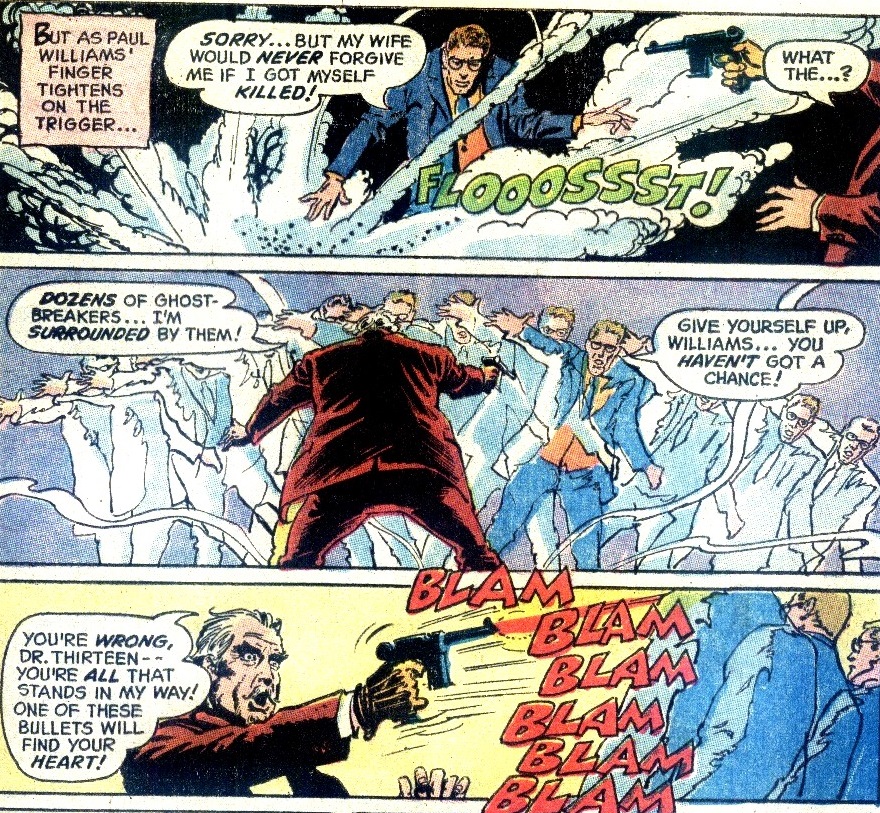
This is a really solid Dr. Thirteen tale. It’s got a good central mystery, wrapped in the appearance of a false enigma. It’s a clever twist on a familiar plot, with a private detective brought in to play unwitting patsy for a nefarious plot, providing an unimpeachable witness for a false reality. The pay-off requires science fiction technology, but for a story taking place in the DC Universe, that is pretty believable. Of course there would be realistic holograms floating around in that world. Thirteen himself is clever and resourceful, not really being taken in by the plot. In only 8 pages, Wein manages to deliver a complete and satisfying mystery, complete with a nice emotional beat at the end. DeZuniga’s art is pretty solid throughout, achieving some really nice effects with some of the holographic sequences. I’ll give this fine backup 3.5 Minutemen. It’s a good and intriguing read, and unlike the title tale, in this one, Wein makes excellent use of his limited space.
And that will do it for this delayed dose of Bronze Age brilliance! We’ve got a solid set of stories, all of them making for at least decent reads, and with a very diverse set of styles. I hope that y’all found them as interesting as I did, and that you’ll join me again (hopefully soon!) for another ed




















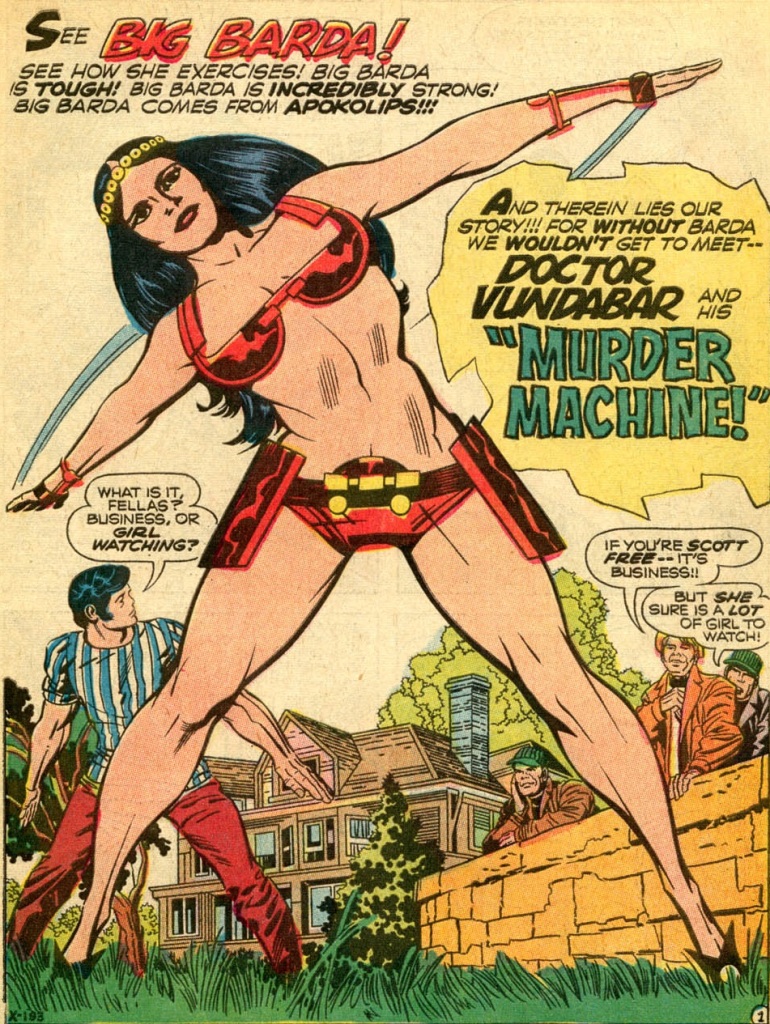






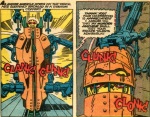






















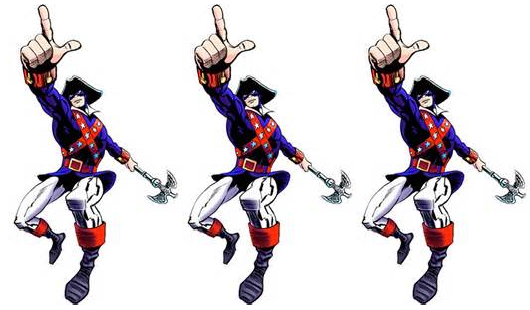



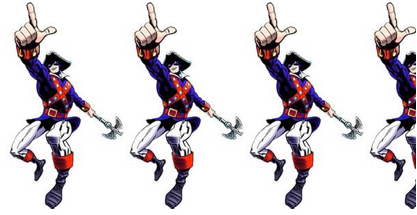
















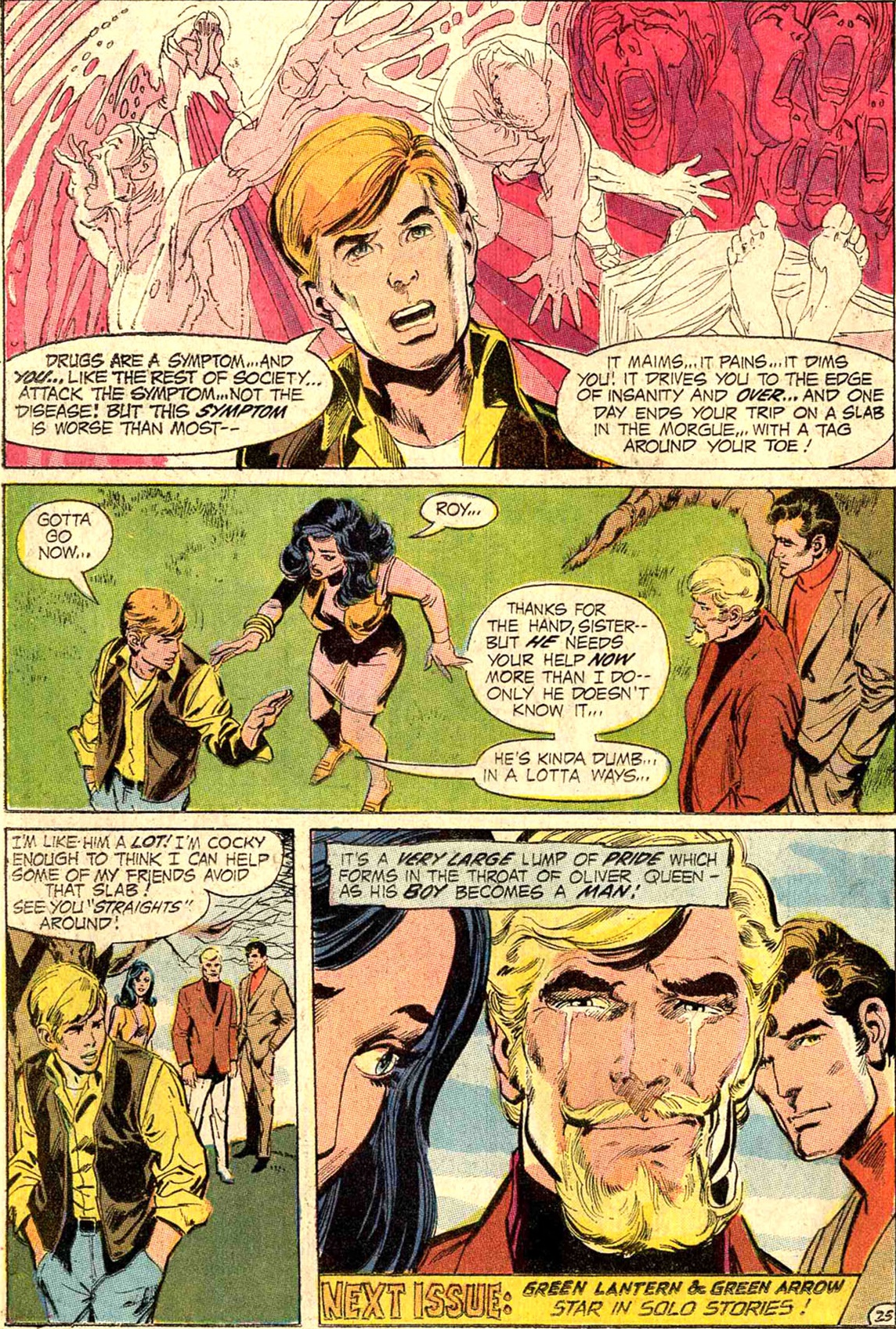







 Suddenly, he’s attacked by refugees from a Robin Hood picture, as a bunch of guys in medieval costumes capture the hero. They drag him into a dungeon, which turns out to be a set in the Galaxy Broadcasting TV studio, conveniently located on this level. Inside is a director, even nuttier than most, who directs his men to kill the interloper so that his death-throes can make for good television! Despite his struggles, Scott is forced into an iron maiden, and all seems lost as the lid slams shut. The whole scene is fun but utterly crazy. It reads like a Fantastic Four issue from the era where Stan and Jack weren’t talking to each other and Stan was thrown into narrative gymnastics in an attempt to explain the bizarre and unrelated images Jack created as his imagination ran away with him. However, this time, there’s nobody to blame for the sudden shift and strange explanation other than Kirby himself. I guess he just wanted to draw an iron maiden, so he shoe-horned the setting in, logic be darned!
Suddenly, he’s attacked by refugees from a Robin Hood picture, as a bunch of guys in medieval costumes capture the hero. They drag him into a dungeon, which turns out to be a set in the Galaxy Broadcasting TV studio, conveniently located on this level. Inside is a director, even nuttier than most, who directs his men to kill the interloper so that his death-throes can make for good television! Despite his struggles, Scott is forced into an iron maiden, and all seems lost as the lid slams shut. The whole scene is fun but utterly crazy. It reads like a Fantastic Four issue from the era where Stan and Jack weren’t talking to each other and Stan was thrown into narrative gymnastics in an attempt to explain the bizarre and unrelated images Jack created as his imagination ran away with him. However, this time, there’s nobody to blame for the sudden shift and strange explanation other than Kirby himself. I guess he just wanted to draw an iron maiden, so he shoe-horned the setting in, logic be darned!




























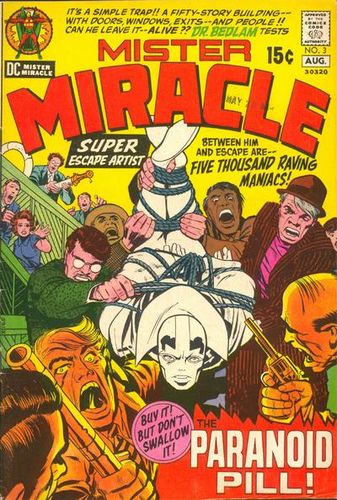















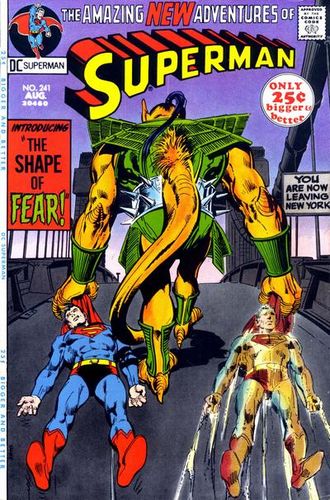



 The hero has suddenly become overbearing, brash, and more than a little selfish, and he begins to handle even the most minor of crimes with outlandish responses, like when he picks up a speeding car and deposits it on top of the Empire State Building (like I said, we’re suddenly in New York). He also meets I-Ching up there at the blind man’s request. The mystic points out this strange behavior and tells Superman that he thinks the Man of Tomorrow suffered brain damage when he was mortal, which enrages the hero. Unable to convince the Metropolis Marvel that something is wrong, I-Ching turns again to magic, all the while talking about how it is a really bad idea because he doesn’t really know what he’s doing. I knew they should have contacted Dr. Fate!
The hero has suddenly become overbearing, brash, and more than a little selfish, and he begins to handle even the most minor of crimes with outlandish responses, like when he picks up a speeding car and deposits it on top of the Empire State Building (like I said, we’re suddenly in New York). He also meets I-Ching up there at the blind man’s request. The mystic points out this strange behavior and tells Superman that he thinks the Man of Tomorrow suffered brain damage when he was mortal, which enrages the hero. Unable to convince the Metropolis Marvel that something is wrong, I-Ching turns again to magic, all the while talking about how it is a really bad idea because he doesn’t really know what he’s doing. I knew they should have contacted Dr. Fate!











 This gambit seems to have worked for a time, but on another stormy night, Rune once again sees the Stranger stalking out of the darkness. In desperation, his servant, Rashid, who had originally trapped the mysterious hero, tries to conjure another spell to banish his spirit. Unfortunately, his power is not up to the task, and in the midst of his incantations, the Stranger appears! Despite the loyal Hindu’s desperate efforts, when Rune flees out into the storm, the Spectral Sleuth follows, and the stolen heart stops beating! Finally, Rune’s allies find him, dead, and lacking a heart!
This gambit seems to have worked for a time, but on another stormy night, Rune once again sees the Stranger stalking out of the darkness. In desperation, his servant, Rashid, who had originally trapped the mysterious hero, tries to conjure another spell to banish his spirit. Unfortunately, his power is not up to the task, and in the midst of his incantations, the Stranger appears! Despite the loyal Hindu’s desperate efforts, when Rune flees out into the storm, the Spectral Sleuth follows, and the stolen heart stops beating! Finally, Rune’s allies find him, dead, and lacking a heart!
























 So, what do we make of this very unusual story? It is an ambitious comic, and Friedrich is really striving to create something significant and provocative. He falls short of most of his aims, but we have to give him credit for his aspirations. Yet, in order to get the message he wants across, he wrenches characters and concepts out of shape, turning Aquaman into an appeaser and a z-list alien race into a major threat without proper development. In the Vietnam era, where American forces were literally burning down and defoliating entire jungles in an attempt to pin down the Viet Cong, responsible use of weapons and accountability for them was a pretty pressing issue. (It just so happens that it remains so in a world of robotic drones bringing comfortably distant death from the skies.) Clearly, there is an attempt here to encourage the audience to grapple with this issue, and that is valuable. Despite its glaring problems of structure, characterization, and logic, Friedrich delivers a very memorable and (relatively) thoughtful comic here. Dick Dillin’s art is serviceable as usual. He renders the Pale People pretty well, but there are some awkward panels scattered about. There are a few places where the art doesn’t quite serve the story, but on the whole, he does a good job. In the end, I suppose this issue deserves 3.5 Minutemen, as its flawed efforts raise it slightly above the average, though I’m inclined to be merciless because of what Friedrich does to my favorite hero, Aquaman.
So, what do we make of this very unusual story? It is an ambitious comic, and Friedrich is really striving to create something significant and provocative. He falls short of most of his aims, but we have to give him credit for his aspirations. Yet, in order to get the message he wants across, he wrenches characters and concepts out of shape, turning Aquaman into an appeaser and a z-list alien race into a major threat without proper development. In the Vietnam era, where American forces were literally burning down and defoliating entire jungles in an attempt to pin down the Viet Cong, responsible use of weapons and accountability for them was a pretty pressing issue. (It just so happens that it remains so in a world of robotic drones bringing comfortably distant death from the skies.) Clearly, there is an attempt here to encourage the audience to grapple with this issue, and that is valuable. Despite its glaring problems of structure, characterization, and logic, Friedrich delivers a very memorable and (relatively) thoughtful comic here. Dick Dillin’s art is serviceable as usual. He renders the Pale People pretty well, but there are some awkward panels scattered about. There are a few places where the art doesn’t quite serve the story, but on the whole, he does a good job. In the end, I suppose this issue deserves 3.5 Minutemen, as its flawed efforts raise it slightly above the average, though I’m inclined to be merciless because of what Friedrich does to my favorite hero, Aquaman.



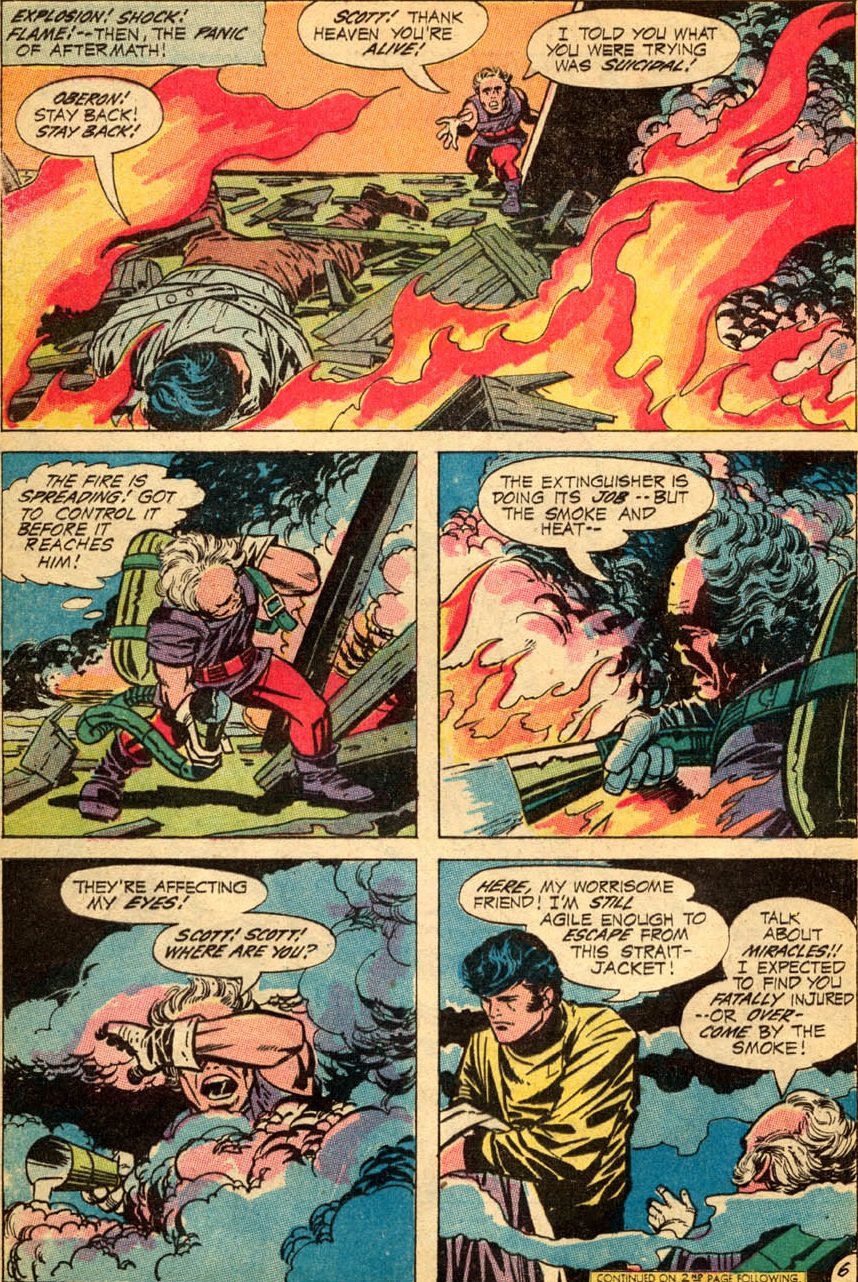
 Meanwhile, our scene changes to focus on a strange old woman surrounded by amazing machines and armored troops. When the soldiers question her about the mysterious machine, Overlord, she throws back her cloak to reveal battle armor and beats them viciously, declaring that the robot is precious to her. She adds that she wants to kill Scott Free and orders her troops to bring him to her. This is our first introduction to
Meanwhile, our scene changes to focus on a strange old woman surrounded by amazing machines and armored troops. When the soldiers question her about the mysterious machine, Overlord, she throws back her cloak to reveal battle armor and beats them viciously, declaring that the robot is precious to her. She adds that she wants to kill Scott Free and orders her troops to bring him to her. This is our first introduction to 
 Scott, for his part, is testing another act, recreating the cover image as he is strapped to a board facing a trio of razor-sharp spears, narrowly avoiding their strike. After his escape, Oberon begins to question him about his origins again, and I quite like his line: “Level with me, boy! You’re not from anyplace I ever heard of–are you–?” Their conversation gives us a nice touch of characterization for both of them, though it reveals little more about Scott, other than that he his on the run and arrived via ‘Boom Tube.’ Of course, folks reading the rest of Kirby’s books would recognize that term. After their talk, Granny’s soldiers arrive and, mistaking the android for Mr. Miracle, capture it and Oberon. Scott sees this and, recognizing the attackers, he takes off after them with flying devices called ‘Aero Disks.’ I’ve always loved this element of the character. When I’m walking a long way, I’ll occasionally daydream about having a pair of these myself!
Scott, for his part, is testing another act, recreating the cover image as he is strapped to a board facing a trio of razor-sharp spears, narrowly avoiding their strike. After his escape, Oberon begins to question him about his origins again, and I quite like his line: “Level with me, boy! You’re not from anyplace I ever heard of–are you–?” Their conversation gives us a nice touch of characterization for both of them, though it reveals little more about Scott, other than that he his on the run and arrived via ‘Boom Tube.’ Of course, folks reading the rest of Kirby’s books would recognize that term. After their talk, Granny’s soldiers arrive and, mistaking the android for Mr. Miracle, capture it and Oberon. Scott sees this and, recognizing the attackers, he takes off after them with flying devices called ‘Aero Disks.’ I’ve always loved this element of the character. When I’m walking a long way, I’ll occasionally daydream about having a pair of these myself!
 Back at Granny’s base, her troops return with their catch, and you can imagine how well she takes it when she realizes they have been suckered. Just then, Mr. Miracle arrives in grand fashion and snags his assistant. Yet, their escape is short-lived, as Granny triggers a device, and the pair drop into something called….the X-Pit! The Pit involves a clear, glass-like cage bearing a number of buttons, which Mr. Miracle calls “a torment-circuit.” Sounds lovely! Kirby gives us a bit of awkward, fuzzy dialog here, but the heart of the trap is a series of tortures corresponding to each button, including flames, electricity, and choking mud. It’s a great sequence, and Kirby draws the heck out of it. The trap itself is pretty clever, as, each press of a button brings relief from one peril, only to replace it with another. That’s an insidious type of torture, giving you control over your own fate.
Back at Granny’s base, her troops return with their catch, and you can imagine how well she takes it when she realizes they have been suckered. Just then, Mr. Miracle arrives in grand fashion and snags his assistant. Yet, their escape is short-lived, as Granny triggers a device, and the pair drop into something called….the X-Pit! The Pit involves a clear, glass-like cage bearing a number of buttons, which Mr. Miracle calls “a torment-circuit.” Sounds lovely! Kirby gives us a bit of awkward, fuzzy dialog here, but the heart of the trap is a series of tortures corresponding to each button, including flames, electricity, and choking mud. It’s a great sequence, and Kirby draws the heck out of it. The trap itself is pretty clever, as, each press of a button brings relief from one peril, only to replace it with another. That’s an insidious type of torture, giving you control over your own fate.








 The next morning, the boy’s mother finds her stricken father dead, seemingly from heart failure, and we observe the fallout from his loss. He was the head of Project Thunderhead, some sort of nuclear weapons undertaking, and the team must choose a new director. There’s a bit of politicking, as an aged German scientist named Heinrich makes a play for the position buts get shot down, starting a plot thread that goes absolutely nowhere. At the slain scientist’s funeral, the Phantom Stranger appears, ruminating that there is a terrible secret in the grave. How mysterious!
The next morning, the boy’s mother finds her stricken father dead, seemingly from heart failure, and we observe the fallout from his loss. He was the head of Project Thunderhead, some sort of nuclear weapons undertaking, and the team must choose a new director. There’s a bit of politicking, as an aged German scientist named Heinrich makes a play for the position buts get shot down, starting a plot thread that goes absolutely nowhere. At the slain scientist’s funeral, the Phantom Stranger appears, ruminating that there is a terrible secret in the grave. How mysterious!





 But let’s think about this plot for a moment. So…this guy somehow made his way to the surface, somehow ended up in an orphanage where the scientist and his wife just happened to come looking for a child, and somehow just happened to be adopted. It’s…a bit of stretch, even without getting into the gonzo antediluvian child-culture that Kanigher pulled out of left field. Regardless of how silly or strange the setup is, the story doesn’t end there. After his explanation, “Freddy” flees from the recovered Stranger, who meets Dr. Clair in his pursuit, only to have her revealed as Tala! She gives her usual ‘join me and we shall rule the galaxy together’ spiel, but he brushes her off. The Stranger chases his quarry back to the caverns from which he emerged, but the kid…err…guy, runs straight into a nuclear test! Despite the scientist’s protestations that “we don’t mean to kill,” our mysterious hero responds with a weird, heavy-handed ‘ye who are without sin, cast the first stone,’ bit about pollution and such that doesn’t entirely makes sense in context.
But let’s think about this plot for a moment. So…this guy somehow made his way to the surface, somehow ended up in an orphanage where the scientist and his wife just happened to come looking for a child, and somehow just happened to be adopted. It’s…a bit of stretch, even without getting into the gonzo antediluvian child-culture that Kanigher pulled out of left field. Regardless of how silly or strange the setup is, the story doesn’t end there. After his explanation, “Freddy” flees from the recovered Stranger, who meets Dr. Clair in his pursuit, only to have her revealed as Tala! She gives her usual ‘join me and we shall rule the galaxy together’ spiel, but he brushes her off. The Stranger chases his quarry back to the caverns from which he emerged, but the kid…err…guy, runs straight into a nuclear test! Despite the scientist’s protestations that “we don’t mean to kill,” our mysterious hero responds with a weird, heavy-handed ‘ye who are without sin, cast the first stone,’ bit about pollution and such that doesn’t entirely makes sense in context.








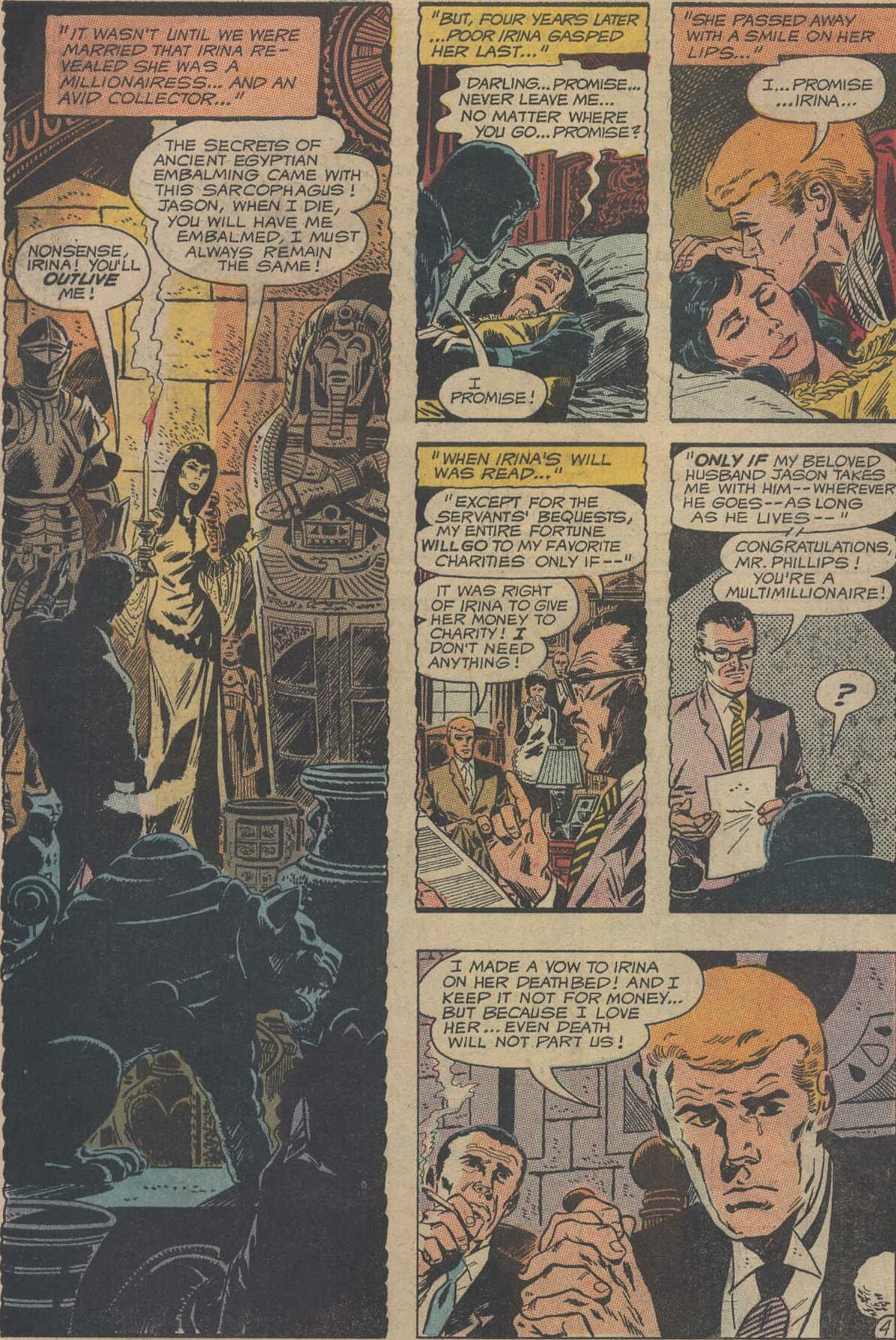







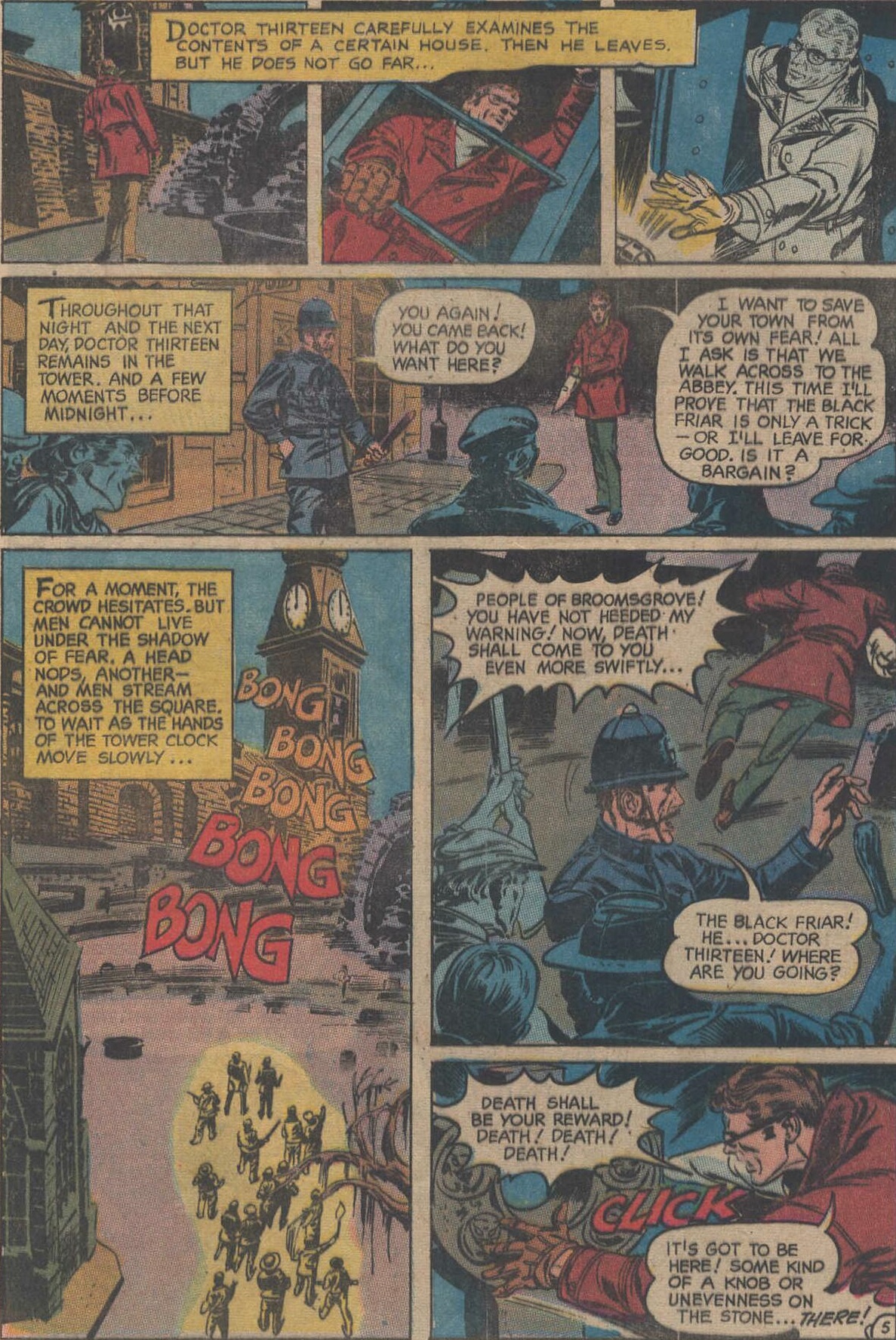








 Needless to say, Pa Kent is rather shocked when an excited crowd shows up yelling about how his son has superpowers, but the new Smallville Spectacle explains things, pointing out that he’s happy he can help his father with his store. Apparently at this point, Pa Kent isn’t a farmer, instead owning a general store, which seems far less fitting, iconic, or archetypal for the character. After another series of super feats, Clark starts to get tired of the constant requests for aid and begins to realize the benefits of a secret identity.
Needless to say, Pa Kent is rather shocked when an excited crowd shows up yelling about how his son has superpowers, but the new Smallville Spectacle explains things, pointing out that he’s happy he can help his father with his store. Apparently at this point, Pa Kent isn’t a farmer, instead owning a general store, which seems far less fitting, iconic, or archetypal for the character. After another series of super feats, Clark starts to get tired of the constant requests for aid and begins to realize the benefits of a secret identity.


 Well, this story wasn’t terrible, but it wasn’t exactly fantastic either. Dorfman wastes the chance to do some actual character work with Clark, botches his mythology, and throws in plenty of goofiness as well. The yarn is entertaining enough, and the section where Superboy gains the godly powers is an interesting change of pace. Yet, that is over in two pages, so we don’t really get a lot of opportunity to see the difference between those and his usual abilities. This story has some potential to be neat, but it ends up being fairly forgettable. I’ll give it 2.5 Minutemen, with the inexplicable ‘Super Clark’ costume costing it some points.
Well, this story wasn’t terrible, but it wasn’t exactly fantastic either. Dorfman wastes the chance to do some actual character work with Clark, botches his mythology, and throws in plenty of goofiness as well. The yarn is entertaining enough, and the section where Superboy gains the godly powers is an interesting change of pace. Yet, that is over in two pages, so we don’t really get a lot of opportunity to see the difference between those and his usual abilities. This story has some potential to be neat, but it ends up being fairly forgettable. I’ll give it 2.5 Minutemen, with the inexplicable ‘Super Clark’ costume costing it some points.




 “The Secret of the Wheel-Chair Superman!”
“The Secret of the Wheel-Chair Superman!”











 “Love Conquers All-Even Supergirl”
“Love Conquers All-Even Supergirl”


